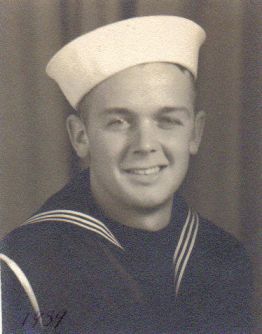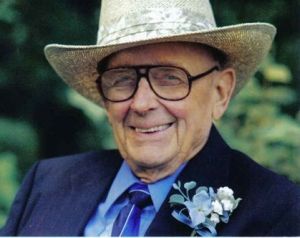USS SLC...USN...Harry Lee Hicks, EM2c
 Harry passed away on May 29th, 2007. Information from his son, Gerald "Jerry"
Harry passed away on May 29th, 2007. Information from his son, Gerald "Jerry"
Dec. 15th, 2008
From written notes documenting his "Life & Times" for his family and heirs.
By Harry Lee Hicks
The spring and summer of 1939 I spent much of it working at various jobs, vegetable farm and a janitor of a sales office in Springfield. All the while I was visiting physicians getting myself where I could pass Navy physical. At this time they were very picky. There was also the fact that I had never had a legal guardian. The lawyer Oscar Puning, who Aunt Eunice worked for volunteered to have himself appointed my guardian. This would cost me nothing and he would handle all the legal matters. I was only 20 after completing all legal steps, passing a mental exam, 3 separate physicals, one in Springfield, and one in St. Louis, final one at Great Lakes.
On September 9th, 1939 I started a 6 year enlistment to do my best to become an electrician which I had been interested in since about 14 years of age. Every Navy document that wanted my reason for joining Navy had the same answer. I completed boot camp; Navy Dr’s removed my tonsils that had given me severe pain every winter for several years. Was happy to be rid of those. I was sent to Marshall Island California to board a transport ship which would take me to Pearl Harbor Hawaii by way of Midway Island.
This transports job was a towing vessel from San Francisco to Midway Island to start clearing a channel at Midway. Fifty (50) civilian workers were also aboard accompanying the equipment. This was the beginning of establishing a permanent naval base at Midway Island. For shipping purposes it was necessary to clear coral and make a shipping channel there.
We were several days getting there as a storm lasting three or four days interrupted our progress. The Navigator reported we at one 36 hour period progressed on true course only 8 knots = 9 miles. Many were very seasick, I was not. Luckily after almost a month the ship arrived at Pearl Harbor having delivered men and equipment at Midway.
My first trip at Sea I shall never forget. This old transport could do all of 13 knots top speed, but we were towing a tug boat. This equipment was to be used in making a shipping channel and harbor at Midway Island. Just 4 days out of San Francisco Ca. a huge storm raged for 36 hours, we struggled in a stormy sea. There were 50 civilians aboard who were construction crewmen going to Midway with equipment we had on board. Many got seasick, we were blown off course and in 36 hours we actually progressed 8 knots on true course. At this time Midway Island was primarily a Pan American Air strip and a small naval detachment. So our mission was sort of the beginning of what was to become a very important Naval Base in the pacific.
I was sent aboard the USS Salt Lake City, a 10,000 ton heavy cruiser. This was my Navy home until September 1942. This ship was launched on the east Coast in 1929, one of two heavy cruisers mounted with a 3, 8” and a 2, 8” gun turret fore and aft capable of firing all 10, 8” guns broadside at once. This of course created a near dangerous list of the vessel. Being built in the 20’s the ship had no modern cooling system for below deck quarters, had an older exhaust system, it was very hot sleeping at times.
My rating began as an apprentice seaman or seaman 3rd class. After 3 months one automatically became seaman 2nd class or if put into a below deck division, you would become a fireman. I remained in the Deck force for about 15 months. After becoming Seaman 1st class I was eligible to put in for transfer to Electrical Division. My transfer request went through, a below deck division called E division. I studied and worked at this job diligently, received good training from the older members.
I finally had achieved what I set out for. I enjoyed the work, established new friends, and a 30 year Chief Warrant Electrician was our Division Officer. He and I got along well. He helped me better understand the theory of what I was working with. I advanced in the rate as fast as I could.
We returned Stateside in December of 1940 for about 3 months for ship renovation. After Christmas I got 14 days leave. I went to see Anne for a few days, went to Chapman area a few days, and then back to Mare islands Navy Yard to continue work. It was a very busy 3 months; lots of combat changes were made but no improvements to our living quarters. Three tier bunk beds were put in to replace Hammocks, which was a lot more convenient but I and many others liked sleeping in hammocks better. Hammocks moved with the ship, bunk bed did not. In a heavy sea one could get dumped.
We spent much of our time at sea, lots of practice of gunnery and war like maneuvers which later proved to be a valuable asset. Our gun crews were TOPs and the ship flew the gunnery E to prove it. The ships crew won the annual Engineering and Gunnery E’s for Excellence and efficiency every year. The top speed of the ship was 33 knots full out. 1 Knot = 1, 1/8” Miles.
As a deck force sailor, I had spent lots of time sweeping, swabbing, holy stoning decks, shining brass work, scrubbing and painting various areas of the ship.
“Holy stoning as described by another sailors diary found on line for reference by Harry's son Gerald to understand what he was referring to.” "Each week, seamen were assigned to "holy stone" these decks. This operation consisted of polishing the decks with a sand stone brick with hole in the middle of it. Each sailor had a long stick not unlike a broom stick, to push and pull the stone fore and aft on the deck. Salt water was used as a lubricant. The net result, other than a lot of sweat, some of which was mine, was that of a beautiful outdoor floor"
Now as a crewman known as an “electrician striker” I was introduced to the tools of the trade, taught at evening classes’ theory and how to read schematic drawings, both mechanical and electrical. Mr. Lambert, our chief Warrant, three Chiefs and two First Class taught these classes. Learning became a habit and had lots of help studying and working with various types of equipment. We had two 35 millimeter carbon Arc movie projectors which I was taught how to operate. These were on Topside. The navy operated a movie exchange in Pearl Harbor where we would exchange reels of film. During peace time we had current movies every night when we started. We later got portable 8mm DeVry projectors to run movies in the mess hall below deck. Of course this was only periodic and we had fewer films. As a Striker I was rotated through each department of the division; lighting, power, and interior communications.
After acquiring the rate of 3rd class I was assigned to the Bell, Buzzer, and annunciator system on the ship. This was a very complex and wide spread system as it ranges to every working station of a ship. Salt water, spray, and air are no friend to electrical systems, so we were all kept very busy with maintaining the electrical equipment. I worked this job under a 2nd class as our evening class work continued. Time to take 2nd class exam came; I was well prepared and passed it OK. Now I was put in charge of the system as the 2nd class also made his next rate and moved to another area. My new helper was a Striker who was a 3rd year College student from Louisiana Tech College who entered the Navy to become a warrant officer. He and I became good friends. He was a good teacher for me so I taught him practical, he taught me the theory. We became good friends, worked well together as well as improved our abilities at our job.
Hawaiian Islands were attacked by the Japanese on December 7, 1941. This was a surprise attack which destroyed most of the Army, Navy, Air force and Warships. The task force I was in was about 400 miles away when this occurred. We were returning from Wake Island, we had escorted the Carrier enterprise delivering some fighter planes to Wake Island to build up the fortification there. Soon after Dec. 7th Wake Island was captured by the Japanese. When we arrived at Pearl Harbor late one evening we went into the harbor which was a horrible sight, fires were burning, and ships were destroyed. It looked as if nothing could be salvaged. (Ship records indicate the ships USS Salt Lake and escort for Enterprise entered Pearl Harbor toward sundown on the eighth.)
We worked all that night taking on fuel, ammo, food etc. Got out before sunrise as it was felt the enemy would return. The other ships of our task force joined us. They had done the same preparing for battle conditions. For three weeks it was our mission to hunt and destroy Japanese submarines on the sea lanes half way between Hawaii and the West coast of the USA. There were plenty of subs out there. Our position was next to the Enterprise on one side to protect the carrier from torpedoes. The light cruisers, and destroyers patrolled outer perimeter and launched depth charges when in range of subs. It was an exciting and frightening 3 weeks. We got little sleep as the subs were there and launching torpedoes trying to hit our ships. We had no ships hit. We believed that a couple of subs had been destroyed.
This ends the written journal report from Harry L. Hicks but we will be searching for more as it appears he may have continued his story on other days and notes yet to be revealed.
Sandy, thank you again for adding this if you can to the records you so diligently keep of these proud and brave men who served our country so well and with such honor on the USS Salt Lake City. I will continue my research and see what else I can learn and if I do come across anything relevant, I'll be sure to send it your way.
Sincerely
Jerry Hicks
USS SLC CA25 Baseball Team, 1941
SLC Deck Logs
Jan. 1942
Sep. 1942
|


 Harry passed away on May 29th, 2007. Information from his son, Gerald "Jerry"
Harry passed away on May 29th, 2007. Information from his son, Gerald "Jerry"
